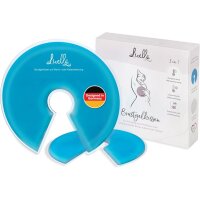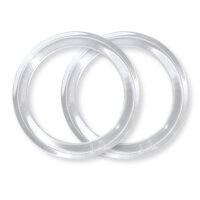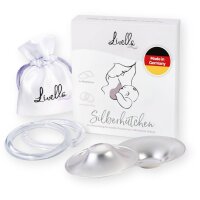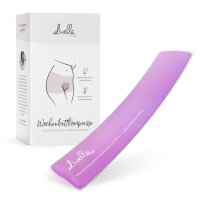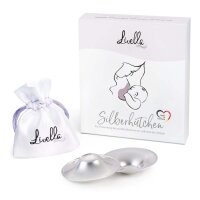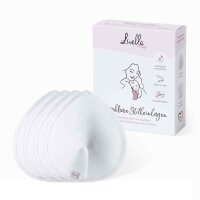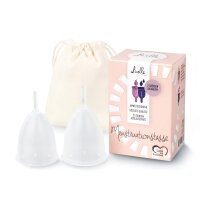Pregnancy is a wonderful experience, but sometimes it can also be a time full of worries. Many mums are concerned about their baby’s healthy development and worry about the next antenatal appointment. A very common concern is the possibility that the baby might be born with a chromosomal disorder.
Luckily, there are many different screening tests available nowadays which can detect potential changes in the baby’s chromosomes already in early pregnancy. One of these screening tests is the so-called nuchal translucency scan (short: NT scan).
What is a nuchal translucency scan? How is it done? How much does it cost? When is the NT scan recommended? Read the answers here.
Table of contents
What is a nuchal translucency scan?
When is a nuchal translucency scan done?
How is the nuchal translucency test done?
How much does it cost to have a NT scan?
When is the best time to perform a nuchal translucency scan?
Pros and cons of nuchal translucency scans
How accurate is the nuchal translucency test?
What happens if the NT scan indicates a condition?
A final word on nuchal translucency scans
What is a nuchal translucency scan?
A nuchal translucency scan (short: NT scan) is a routine screening test in antenatal care. The purpose of the test is to screen for chromosomal disorders in the baby. The screening can reveal first signs that the baby might be born with a trisomy (e.g. trisomy 21).
The screening involves measuring the baby’s nuchal fold using ultrasound. The NT scan is usually offered in the form of a combined test and determines the likelihood of the baby having certain chromosomal anomalies.
In the UK, the combined test is offered to all pregnant women as part of standard antenatal care. It is the first test that can be performed to screen for Down’s, Patau’s and Edward’s syndrome. However, it’s up to the mother to decide if she wants to have this screening or not.
When is a nuchal translucency scan done?
In contrast to other countries where nuchal translucency is only measured if there is an increased risk for a chromosomal disorder in the baby, the NT scan is part of standard prenatal care in the UK. It is offered to all mums-to-be and often takes place during the dating-scan appointment.
It is up to the mother to decide if she wants to have the scan or not. Factors that increase the risk of the baby being born with a chromosomal disorder include advanced maternal age. In this case, having the test is often recommended.

How is the nuchal translucency test done?
Before the actual screening, there is an in-depth consultation with the treating doctor or sonographer. During the consultation, the mother can ask any questions she might have. In addition to the medical aspects of the screening, the health professional will also talk about different psychosocial aspects.
After the mother has agreed to have the scan (usually she needs to give her written consent), the sonographer will perform the screening. Using ultrasound, the sonographer will measure the fluid at the back of the baby's neck. Increased thickness of the nuchal fold can be indicative of a chromosomal disorder.
Based on the measurements taken by ultrasound, the health professional calculates the risk of the baby having a chromosomal condition. The mother’s age is also taken into account in the calculation, as well as any other anomalies detected in the baby’s organs or bone structures.
How much does it cost to have a NT scan?
The NT scan is offered as a combined test that includes the ultrasound scan and a blood test. It is an integral part of the screening tests which are done to detect early signs of Down’s, Patau’s and Edward’s syndrome. As part of standard prenatal care, it is offered free of charge.
When is the best time to perform a nuchal translucency scan?
If the mother agrees to have a NT scan, the test is performed during the dating scan. In this case, the NT screening takes place between 10 and 14 weeks of pregnancy. If the dating scan takes place later, it is generally too late to measure nuchal translucency and a different screening test for chromosomal disorders will be offered instead.
The reason why nuchal translucency is measured between weeks 10 and 14 is that this is the best time to detect a thickened nuchal fold. The fluid accumulation in the neck is linked to the development of the baby’s lymphatic system which takes place at this stage.
The best results for the measurement are usually achieved in week 12 of pregnancy. Measurements taken after 14 weeks of pregnancy are not reliable anymore because this is when the accumulated fluid in the baby’s nuchal fold starts to recede.

Pros and cons of nuchal translucency scans
A nuchal translucency scan is a non-invasive ultrasound scan which is considered safe for mother and baby. Nevertheless, many mums-to-be are unsure about whether they want to have the scan or not. That’s because there are also some downsides to having a NT scan.
A normal NT measurement can help put parents at ease. Depending on the calculated risk of a chromosomal disorder, further tests can be done to get clarity on whether the baby might be born with a condition. This gives parents-to-be more time to come to terms with what the diagnosis will mean for their family life.
However, prenatal screening test results can also be distressing. Future mums and dads therefore need to carefully think about whether they really want to know if their baby will be born with a genetic condition.
Also, screening tests don’t always deliver accurate results. A false positive result (i.e. the test indicates a chromosomal disorder although there is none) causes unnecessary emotional stress and worry. A false negative result (i.e. the test shows that there are no chromosomal changes although the baby has a condition), on the other hand, will lead to a bad surprise at birth.
An alternative non-invasive screening test for chromosomal disorders that delivers more reliable results is the so-called NIPT (non-invasive prenatal testing), which is a blood test that also screens for trisomies. However, the NIPT doesn’t deliver definitive results either, but must be followed by further tests.
NT scan advantages and disadvantages at a glance
Arguments in favour of a nuchal translucency scan:
- Measuring nuchal translucency is a non-invasive screening test. This means that there are no known risks for mother and baby.
- A lower-chance result can give peace of mind.
- Detecting chromosomal anomalies early gives parents-to-be enough time to come to terms with the consequences of the diagnosis.
Arguments against a nuchal translucency scan:
- A false positive test result causes unnecessary worry.
- The screening test doesn’t deliver a clear diagnosis but merely calculates the risk of a chromosomal disorder. This means that further tests are needed for confirmation.
- Knowing that their baby will be born with a condition is very distressing for future parents.
How accurate is the nuchal translucency test?
Mums-to-be often struggle to understand the measurements and calculations that are done during a NT scan. The general rule is: The higher the NT measurement, the higher the risk of a chromosomal anomaly in the baby. The exact NT measurement and what it means will be explained after the scan by the sonographer. Results are typically presented in the form of a risk calculation, such as 1:500 or 1:1000.
What’s important: Mums-to-be should keep in mind that the results of a nuchal fold translucency test don’t represent a final diagnosis. The test merely helps health professionals calculate the risk of a chromosomal disorder.
The risk is calculated based on the NT measurements taken during the ultrasound scan. Depending on the situation, other factors might be taken into consideration. For instance, certain anatomical features of the baby, such as the foetal nasal bone, might be monitored more closely.
In addition to the NT scan, the combined test to screen for trisomies 13, 18 and 21 also includes a blood test which measures the PAPP-A levels. The mother’s PAPP-A levels are another marker for chromosomal disorders. Screening results obtained from a nuchal translucency scan alone are less accurate compared to a full combined test.
What happens if the NT scan indicates a condition?
If nuchal translucency measurements indicate that the baby might have a condition, further confirmatory tests are needed. That’s because NT scans merely provide a risk calculation, but not a diagnosis as such.
A final diagnosis can only be provided based on an invasive diagnostic test. Diagnostic tests that provide clarity on the presence or absence of chromosomal disorders are amniocentesis (i.e. amniotic fluid test) and chorionic villus sampling (i.e. sampling tissue from the placenta).
A final word on nuchal translucency scans
- Nuchal translucency measurements are typically done as part of a combined test that also includes a blood test.
- The NT scan is performed between 10 and 14 weeks of pregnancy.
- The ultrasound scan measures the amount of fluid that has accumulated in the baby’s nuchal fold.
- The scan is used to calculate the risk of the baby having a chromosomal disorder (e.g. Down’s, Edward’s and Patau’s syndrome).
- In the UK, the combined test is offered to all mums-to-be as part of standard antenatal care.
- The main drawback of the screening test is that it doesn’t provide a clear diagnosis but merely indicates whether there is a low or high risk of the baby having a chromosomal condition.
False positive results can further cause unnecessary distress for future parents.
References
- Ersttrimester-Screening - familienplanung.de
- https://shop.bzga.de/pdf/13625100.pdf
- Mu-RL_2023-09-28_iK-2023-12-19.pdf (g-ba.de)
- Ultraschalluntersuchungen in der Schwangerschaft (gesundheitsinformation.de)
- https://www.focus.de/familie/eltern/tipps-fuer-eltern/nackenfaltenmessung-wann-und-wie-hoch-sind-die-kosten
- Rundum - Schwangerschaft und Geburt - BZgA Shop
- Nackenfaltenmessung: Diese Krankenkassen übernehmen die Kosten
- Bluttests auf Trisomien - familienplanung.de
- Schwangerschaftserleben und Pränataldiagnostik - BZgA Shop
- https://shop.bzga.de/pdf/13329205.pdf


